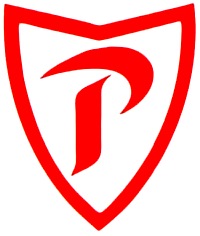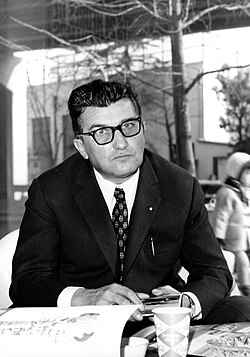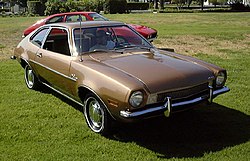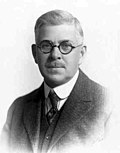Portal:Cars
The Cars PortalA car, or an automobile, is a motor vehicle with wheels. Most definitions of cars state that they run primarily on roads, seat one to eight people, have four wheels, and mainly transport people rather than cargo. There are around one billion cars in use worldwide. The French inventor Nicolas-Joseph Cugnot built the first steam-powered road vehicle in 1769, while the Swiss inventor François Isaac de Rivaz designed and constructed the first internal combustion-powered automobile in 1808. The modern car—a practical, marketable automobile for everyday use—was invented in 1886, when the German inventor Carl Benz patented his Benz Patent-Motorwagen. Commercial cars became widely available during the 20th century. The 1901 Oldsmobile Curved Dash and the 1908 Ford Model T, both American cars, are widely considered the first mass-produced and mass-affordable cars, respectively. Cars were rapidly adopted in the US, where they replaced horse-drawn carriages. In Europe and other parts of the world, demand for automobiles did not increase until after World War II. In the 21st century, car usage is still increasing rapidly, especially in China, India, and other newly industrialised countries. Cars have controls for driving, parking, passenger comfort, and a variety of lamps. Over the decades, additional features and controls have been added to vehicles, making them progressively more complex. These include rear-reversing cameras, air conditioning, navigation systems, and in-car entertainment. Most cars in use in the early 2020s are propelled by an internal combustion engine, fueled by the combustion of fossil fuels. Electric cars, which were invented early in the history of the car, became commercially available in the 2000s and widespread in the 2020s. The transition from fossil fuel-powered cars to electric cars features prominently in most climate change mitigation scenarios, such as Project Drawdown's 100 actionable solutions for climate change. (Full article...) Entries here consist of Good and Featured articles, which meet a core set of high editorial standards.
The Ford Pinto is a subcompact car that was manufactured and marketed by Ford Motor Company in North America from 1970 until 1980. The Pinto was the first subcompact vehicle produced by Ford in North America. The Pinto was marketed in three body styles throughout its production: a two-door fastback sedan with a trunk, a three-door hatchback, and a two-door station wagon. Mercury offered rebadged versions of the Pinto as the Mercury Bobcat from 1975 until 1980 (1974–1980 in Canada). Over three million Pintos were produced over its ten-year production run, outproducing the combined totals of its domestic rivals, the Chevrolet Vega and the AMC Gremlin. The Pinto and Mercury Bobcat were produced at Edison Assembly in Edison, New Jersey, St. Thomas Assembly in Southwold, Ontario, and San Jose Assembly in Milpitas, California. (Full article...) Selected article - The Prince Motor Company (Japanese: プリンス自動車工業株式会社) was an automobile marque from Japan which eventually merged into Nissan in 1966. It began as the Tachikawa Aircraft Company, a manufacturer of various airplanes for the Japanese Army in World War II, e.g., the Ki-36, Ki-55 and Ki-74. Tachikawa Aircraft Company was dissolved after the war and the company took the name Fuji Precision Industries. It diversified into automobiles, producing an electric car, the Tama, in 1946, named for the region the company originated in, Tama, using the Ohta series PC/PD platform. The company changed its name to Prince in 1952 to honor Akihito's formal investiture as Crown Prince of the nation. In 1954 they changed their name back to Fuji Precision Industries, and in 1961 changed the name back again to Prince Motor Company. In 1966, they became part of Nissan, while the Prince organization remained in existence inside Nissan, as Nissan Prince Store in Japan until Nissan consolidated the Prince dealership network into "Nissan Blue Stage" in 1999. (Full article...) Selected picture of the day
Selected biography - Ferruccio Lamborghini Cavaliere di Gran Croce OMRI (/ˌlæmbərˈɡiːni/ LAM-bər-GHEE-nee; Italian: [ferˈruttʃo lamborˈɡiːni]; 28 April 1916 – 20 February 1993) was an Italian automobile designer, soldier, inventor, mechanic, engineer, winemaker, industrialist, and businessman who created Lamborghini Trattori in 1948 and the Automobili Lamborghini in 1963, a maker of high-end sports cars in Sant'Agata Bolognese. Born to grape farmers in Renazzo, from the comune (municipality) of Cento, in the Emilia-Romagna region, his mechanical know-how led him to enter the business of tractor manufacturing in 1948, when he founded Lamborghini Trattori, which quickly became an important manufacturer of agricultural equipment in the midst of Italy's post-WWII economic boom. In 1959, he opened an oil burner factory, Lamborghini Bruciatori, which later entered the business of producing air conditioning equipment. (Full article...) On this day August 8Did you know...
Selected quote of the dayTopicsGeneral imagesThe following are images from various car-related articles on Wikipedia.
CategoriesThings you can do to help If you wish to help, you can:
Associated WikimediaThe following Wikimedia Foundation sister projects provide more on this subject:
Discover Wikipedia using portals |

































































